#like does he just take a second in pig city to break the fourth wall and give the player a little wave
Explore tagged Tumblr posts
Text
hi pizza tower community this matters to no one but me but noise does this 1 second animation that i've only noticed occurs consistently in pig city and its just this
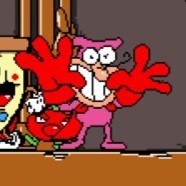
hey man do you need something.
#like does he just take a second in pig city to break the fourth wall and give the player a little wave#after breaking him out of jail#pizza tower#theodore noise
23 notes
·
View notes
Text
Zero Room for Error
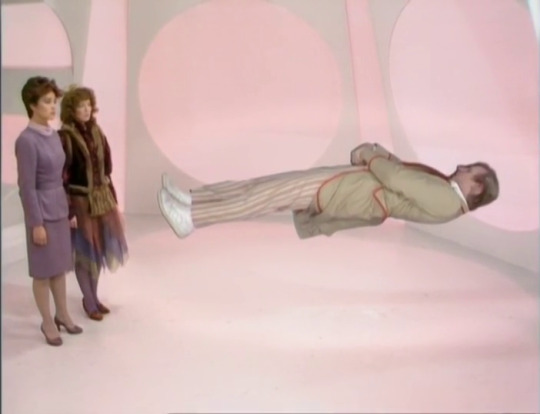
Over his seven-year reign as the Doctor, Tom Baker had his ups and his downs. While seen as the definitive Doctor by many, towards the end, even Baker himself was tiring of the role. On top of that, the writing had begun to border along the outlandish. In "The Power of Kroll," the Doctor saves himself and others by emitting a high pitched scream that shatters glass. In another story, he saves the very metallic K9 from a furnace with his bare hands. However, it would seem that such heroics go back even as far as "The Android Invasion," where the Doctor jumps from the top of a building, unscathed. Ironic then, that a drop from a radio telescope not that much higher, should spell his death. Perhaps this was just the first of many course corrections the new showrunners hoped to achieve- bringing the Doctor back down to earth, so to speak.
With the introduction of Peter Davison as the Fifth Doctor, "Castrovalva," seems the most interested in lending some vulnerability to the character. There's a sort of pensive quality to a character having freshly fallen to his death. It spells out a very "look before you leap," plan of action moving forward. Sure, being the action hero is badass, but in the words of Dennis Reynolds- "You know what's badass? Being alive." But how much of Castorvalva is being economical, and how much of it is just plain stingy?
After a very weird regeneration scene involving "the Watcher," Tegan, Nyssa, and Adric rush the Doctor toward the safety of the TARDIS, all the while being chased by security guards leftover from "Logopolis." It's a fairly pointless scene that could have just picked up inside the TARDIS, but it's a chance to see Anthony Ainley's pillar of a TARDIS show a little menace, shocking the guards and Adric. Nyssa's remark about hating his face marks the first and last time she will ever mention the Master wearing her dead father's face- a plot point which I feel went woefully unexplored. At this time, there's not a lot of sense as to how or why the Master fits into the story, other than "He was in the last one."
Inside the TARDIS, the Doctor's regeneration is acting up, requiring him to need the use of the "Zero Room," a previously unmentioned area deep within the TARDIS. Along with misnaming his companions, he's also reliving past incarnations, allowing us to see Davison's impressions of both the First and Second Doctors, which admittedly aren't too bad. (His First Doctor is better than David Bradley's! Yeah I said it!) When I first watched this episode, I was horrified to find the Doctor unravelling the iconic scarf of his predecessor. But upon today's viewing, I saw it as a rather gutsy move on the writer, Christopher Bidmead's behalf. Leaving the thread behind as a trail of bread crumbs back to the console room is exactly something the Doctor would do.
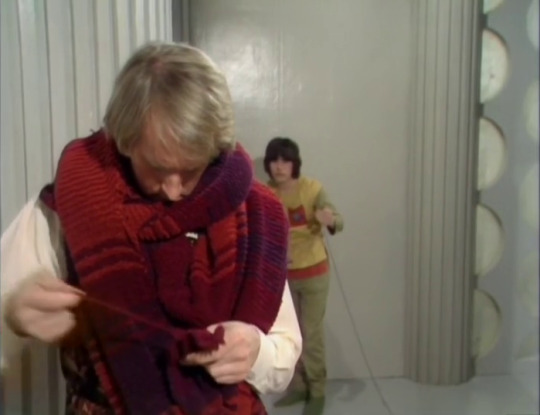
After putting the TARDIS into motion, Adric follows the Doctor into the depths of the TARDIS. Meanwhile, Nyssa and Tegan desperately try any information on the TARDIS computer that might help the Doctor. Their conversation waxes philosophical about recursion and the word "if," which leads Tegan to wonder if the TARDIS index file could be reached by typing "I.F." into the console, which it does. This gives them the information they need to find the Zero Room and help the Doctor.
While the Doctor is searching, he finds the pieces of what will become his new costume, with a few red herrings peppered in. While he takes to the cricketer uniform, he leaves the recorder and big green wellies behind. The cricket bat needing a bit of linseed oil shows us that there appears to be an entire room of the TARDIS dedicated to the sport of cricket. One is led to wonder if there are other rooms dedicated to other sports and whether they're all British pastimes. While the concept of an Anglophile alien with a cricket room is rather absurd, it's the making stuff of Doctor Who.
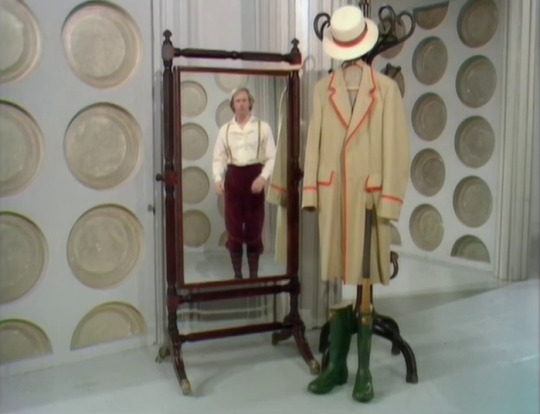
After the disappointing portrayal of the TARDIS that was "The Invasion of Time," it was nice to see a more sci-fi interior. While it was clearly the same corridor elements rebuilt, and rearranged, it was still better than an old hospital with ugly whitewashed brick walls. These corridors at least felt like they belonged in a space ship. Even the Zero Room does a nice job of developing the TARDIS a little bit. That being said, it also undoes a bit of its own hard work, the second it gets introduced.
The Doctor explains to Tegan and Nyssa that the room is completely unaffected by outside influences. Even the gravity is equalised. Being inside this room has already improved the Doctor's cognitive faculties, as evidenced by his ability to get his companion's names right. He begins to levitate where he will suspend himself until his regeneration is complete. But this is interrupted by outside forces, when the Master appears on a screen, with Adric tied up like his leather slave in some sort of web. It's like the razor wire scene from the "Suspiria" remake with none of the real danger. How the Master is able to penetrate the Zero Room, or how he kidnapped Adric is anyone's guess. Is Adric even there? It’s not made clear.

The Master sends the TARDIS on a collision course with the formation of a galaxy. You may remember this danger from another TARDIS heavy story- "The Edge of Destruction." Only instead of trying to stab one another with scissors, the TARDIS fills up with hydrogen and threatens to explode. The Doctor jettisons various rooms from the TARDIS, enabling him to convert the matter into energy, allowing them to thrust away from the event, and into safety. The only problem is, this also jettisons the Zero Room in the process. This bit has always confused me, as the TARDIS seems almost nigh-infinite inside. Rooms seem less like physical spaces, and more like files on a computer. Couldn't they just make another Zero Room?
Nyssa and the Doctor set about building a to-go Zero Room out of its doors, encasing the Doctor in it like a coffin made out of TARDIS wall. There in goes our hero, where he will sleep much of the story away. Back to the Master and Adric, still tied up and writhing in a way that will leave those of us not on a watchlist feeling uncomfortable. Bless Matthew Waterhouse, he's acting his little ass off, and he's still awful. The Master then tortures Adric until he agrees to help him. This betrayal under duress is never explored further, it's just a bit of light betrayal that will become common for Adric.
After reading on the TARDIS computer of a place called Castrovalva, Nyssa and Tegan decide to take the Doctor there to regenerate in peace. Upon arriving, the deep forest is unkind to the high heel wearing duo as they wheel the Zero Coffin around on a wheelchair. Nyssa's poor choice of footwear lands her waist-deep in some peaty water, which leads to an admittedly rather adorable reaction shot on Sarah Sutton's behalf. I was struck with the utter cheapness that was this scene. I tried to imagine Clara Oswald pushing a silly white box around on a wheelchair, and it just didn't scan. The companions of old really don't get enough appreciation. They were asked to sell some pretty stupid stuff.
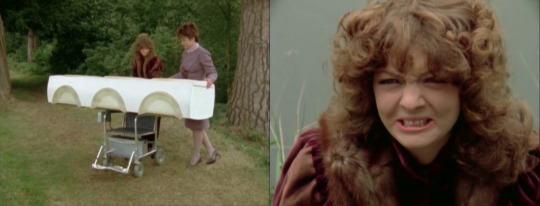
While looking for Castrovalva (which is evidently the city, not the planet), our heroes are being stalked by men dressed as a cross between a Weber grill and a muppet. After some pointless padding in the form of running about, they are captured and subjected to a surprising level of hospitality. After removing their hunting gear, we see that the Castrovalvans are an intelligent people, whose only real shortcoming as a society is their choice of headgear. They allow Tegan and Nyssa the comforts of home, while the Doctor sleeps. That evening they roast a pig over the fire, which made me laugh a little. Something about seeing earth animals on alien planets always feels a little odd to me. Sure, there are humans, but that makes more sense than say a mouse in Jabba's palace, or PIGS IN SPAAAAACE.

A lot of the action at this point has come to a dead standstill. The Doctor is sleeping most of the adventure away, which is, to me at least, the worst way to do a regeneration episode. Pertwee was asleep for Spearhead, Davison sleeps through Castrovalva, Tennant sleeps while a Christmas tree wrecks Jackie Tyler's living room... Even Capaldi and Jodie sleep through their regenerations. This does lend the story a sense of urgency, but usually, it's more boring than anything. I much prefer a Matt Smith style "I'm still cooking," manic start, than the Peter Davison sleepy time show.
Once Davison is up, he does a decent enough job filling in the shoes of the Doctor. Though upon my first viewing of the story, I did not think so at all. Going from Tom Baker to Peter Davison was like going from the toy store to the bank. The Fourth Doctor is my favourite Doctor, so it just wasn't very exciting for me. And like I said, I can see now why they may have wanted to tone the Doctor down a bit. Davison is your father's Doctor. His performance is more subtle. Only now am I even coming around to a point where I appreciate what he does, which is what brought me to this story in the first place. I've been revisiting him with a renewed interest.
The episode ends after the Doctor discovers the city is in a state of recursion. Like an Escher drawing, the physical layout of the castle loops in and out of itself, trapping its inhabitants, except for when they need to go hunting. (I guess?) The Master, of course, has been there all along in old man double-hat drag. The Doctor tricks the Master into thinking he's still in the Zero Coffin by filling it with books on the history of Castrovalva. While the Master shoots a box, the Doctor is rallying the citizens of Castrovalva and breaking them of the spell of recursion, allowing them to see with eyes unclouded.
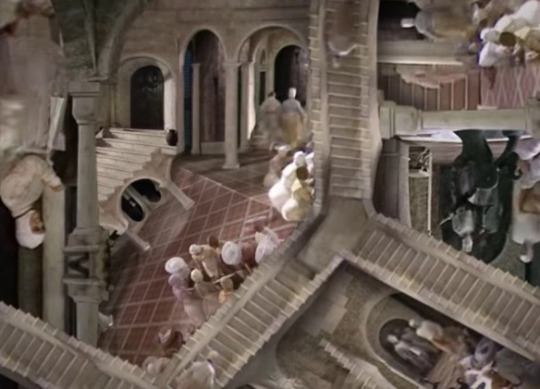
After revealing a tapestry is actually the web that holds Adric, using his mathematical mind to maintain the lie that is Castrovalva, their leader Shardovan destroys the web with a chandelier, causing the city to begin to collapse. The Doctor, his friends, and Adric flee to safety. The Master is not so lucky, as the people tear at him like an angry mob. He becomes trapped inside the city as it fades into nothingness. Upon returning to the TARDIS, the Doctor finds Tegan's landing job askew but assures her that she didn't actually fly the TARDIS, much to her disappointment. I too was a little disappointed. It would have been nice to see the flight attendant become a pilot. It did, however, lead to what I consider one of my favourite Doctor Who memes.
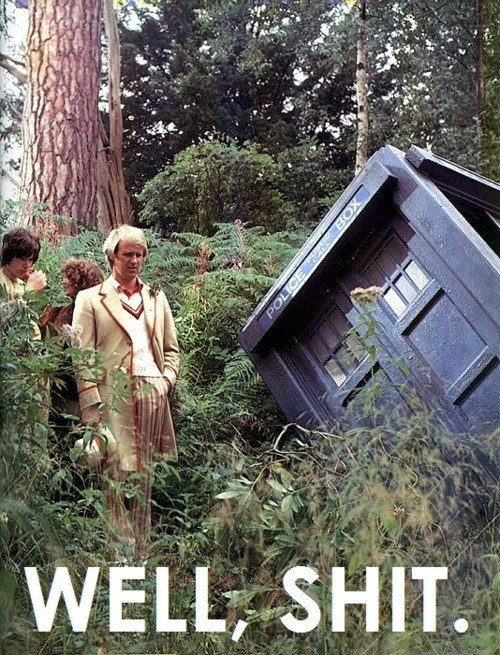
As a "Doctor's first story," goes, I've seen worse. "The Twin Dilemma," will always hold the "What were they thinking?" title. But on its own, I'm not sure I would say it's a wholly successful story. Lots of the plot points are glossed over, and/or made no sense. But there are a lot of things I like about the serial. It's a rare occurrence where the companions were each given a little something to do, despite the crowded TARDIS. I even found Adric tolerable in this one. The world of Castrovalva was uniquely designed and could have stood up to even further exploration. Although I would suggest watching the special edition, as it does the Escher bit far more justice. I also appreciate any episode that incorporates more of the TARDIS into the story. It seems most writers treat our old girl as simply a means of conveyance, which is unfortunate. I wish they would have allowed Davison to maintain a bit of the zaniness from these few episodes, as they promised a Doctor that was a little more cheeky than the one we got. But by the end of it all, he's got his friends, he's got his TARDIS, and he's got his celery. It's hard not to want to watch the next episode.
#Doctor Who#Fifth Doctor#peter davison#nyssa#tegan jovanka#adric#sarah sutton#janet fielding#matthew waterhouse#castrovalva#tardis#recursion#if#the master#anthony ainley#Time and Time Again
14 notes
·
View notes
Link
Architecture is suffering a crisis of confidence. More and more mainstream figures in the field are admitting that the profession has lost its way. As I previously mentioned, Frank Gehry, the world’s most famous architect, recently said that “98% of everything that is built and designed today is pure sh*t. There’s no sense of design, no respect for humanity or for anything else.” Architectural thought-leaders seconded and thirded him. And he’s since been fourthed by another.
…
And now The New York Times, the ultimate arbiter of elite opinion, recently published an op-ed that declared, “For too long, our profession [architecture] has flatly dismissed the general public’s take on our work, even as we talk about making that work more relevant with worthy ideas like sustainability, smart growth and ‘resilience planning.’” The authors are not kooks on the fringe but architect Steven Bingler and Martin C. Pedersen, former executive editor of Metropolis magazine, both of them very much in the establishment.
The authors observe that self-congratulatory, insulated architects are “increasingly incapable … of creating artful, harmonious work that resonates with a broad swath of the general population, the very people we are, at least theoretically, meant to serve.” Bingler and Pedersen note that this has been a problem for over forty years (my emphasis), and that things are even worse today.
As a case in point, they mention the 2007 “Make It Right” charity program, founded by amateur architect and furniture designer Brad Pitt. The program invited firms, most of them avant-garde, to design housing for poor New Orleanians whose homes were destroyed by Hurricane Katrina. The architecture world was exhilarated: The initiative was to be a showcase for how the best contemporary design could improve lives.
The predictable result was weird, sometimes discomforting houses of non-native motley futuristic design that have virtually no relation to each other or the beloved historic architecture of the city. A story in The New Republic called the 90-some houses a waste of money and a distracting sideshow: The homes were expensive to build ($400,000 on average) and the high-tech fabrication has made them expensive to fix; mold has grown on the untested experimental materials, and the eco-wood decks and stairs are already rotting. The neighborhoods are wastelands—failures of urban planning that isolate residents from social networks and public services.
…
While most of the architectural establishment has responded to the op-ed with noticeable silence, Mark Lamster, architecture critic for the Dallas Morning News, did bravely publish a post on Facebook in which he began by quoting the opinion piece: “We’ve taught generations of architects to speak out as artists, but we haven’t taught them how to listen.” Lamster then commented, “super-smart nyt op-ed from Martin Pedersen and steven bingler [sic].”
What is most telling, however, is the vitriolic response the op-ed triggered in Aaron Betsky. Called “one of the 21st century’s architectural power brokers,” Betsky is the former head of the Cincinnati Art Museum, and was director of the 2008 Venice International Architecture Biennale, the most important architecture show in the world. An architectural priest and patrician, he is to the profession what The New York Times is to the chattering classes: a voice of the high-status quo. Indeed, he writes for Architect, the official magazine of the AIA.
Betsky rained down on Bingler and Pedersen with ridicule and scorn: Their piece was “so pointless and riddled with clichés as to beggar comprehension.” He summarized their position: “we have three of the standard criticisms of buildings designed by architects: first, they are ugly according to what the piece’s authors perceive as some sort of widely-held community standard (or at least according to some 88-year old ladies); second, they are built without consultation; third they don’t work.”
Yet Betsky then admitted, “All those critiques might be true.” They are irrelevant, he claims, since architecture must be about experimentation and the shock of the new. (Why this should be the case he does not say.) And sometimes designers must stretch technology to the breaking (or leaking) point: “The fact that buildings look strange to some people, and that roofs sometimes leak, is part and parcel of the research and development aspect of the design discipline.” Ever brave, he is willing to let others suffer for his art.
At no point did Betsky consider the actual human beings, the unwilling guinea pigs who live in the houses. He implicitly says of the poor residents: Do their roofs leak? Let them buy buckets. And as for sickness-inducing mold, there’s Obamacare for that. Betsky also does not consider what a leaky roof means to people whose prior homes were destroyed by water. The architects, having completed their noble experiments, effectively say like the arrogant King Louis XV of France: “Après moi, le deluge” [After me, the flood]. No wonder architects have an image problem.
Betsky also would not appear to care that some of the new houses look like they have already been damaged by a flood. As he wrote in May, “Buildings under decay are much sexier than finished ones, perhaps because they remind us of our own mortality.” It logically follows that the “decaying” Katrina houses are simulated ruin porn, a pleasing mix of sex and death. He had previously said that the decay of New Orleans even prior to the hurricane could seem “elegant” to some. One of his favorite architects, the Dutch firm MVRDV, proposed a Make It Right house that looked like a trailer broken in two, and another one that looked like a house piled on top of a house.
…
Modernist architecture, like Modern art, has tended to be a revolt against bourgeois taste (and values): If granny, abuelita, or bubbe is for it, they’re against it. But if bourgeois taste is bad—all that chintz and those lace curtains, those cushy sofas, that flag flown from the front porch—just imagine what architects think of the working class and poor. If the architects had their way, elevator music in New Orleans public housing would be screeching Stockhausen, not native Louis Armstrong or Fats Domino. Modernists have no room for harmony, rhythm, or soul; they are high-culture elitists, not multiculturalists who celebrate class and ethnic diversity.
Many leading 20th-century architects, including Philip Johnson and Mies van der Rohe, were openly disdainful of the public’s preferences. On occasion they evinced subtle and overt racism. In 1913, in one of the most influential essays in the history of Modernist architecture, “Ornament and Crime,” [PDF] the Austrian architect Adolf Loos declared that modern man (read: white northern Europeans) must go beyond what “any Negro” could achieve in design, and strip away all that is superfluous, all that is morally and spiritually polluted. It is Papuans and other primitives who, like innocent children, ornament themselves with tattoos. Loos’ race has superseded them: “the modern man who tattoos himself is either a criminal or a degenerate.” The same held for ornament in architecture. (To this day, architects—who continue to believe they are the vanguard of civilization’s progress—find ornament retrograde. Yet ordinary people stubbornly continue to adorn themselves with cosmetics, jewelry, and, yes, tattoos.)
In the 1920s, during the time he was a member of the French Fascist party, the seminal architect Le Corbusier said he was disgusted by the “zone of odours, [a] terrible and suffocating zone comparable to a field of gypsies crammed in their caravans amidst disorder and improvisation.” He also chimed in with Loos: “Decoration is of a sensorial and elementary order, as is color, and is suited to simple races, peasants, and savages… The peasant loves ornament and decorates his walls.”
…
Betsky, to his credit, doesn’t pretend that architects should even try to make outreach. Showing little sympathy for democracy, he says that appeals to the public are “mystical.” The people—the 99%—do not deserve a seat at the table. Yet Betsky would have us believe that he and the architecture he supports are “progressive.”
15 notes
·
View notes